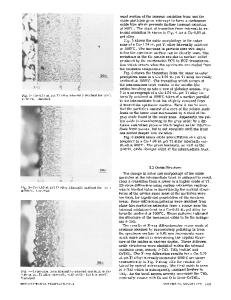Selective oxidation and internal nitridation during high-temperature exposure of single-crystalline nickel-base superall
- PDF / 1,956,008 Bytes
- 10 Pages / 612 x 792 pts (letter) Page_size
- 36 Downloads / 239 Views
I. INTRODUCTION
THE Ni-base superalloys are commonly used for hightemperature applications, e.g., turbine blades of industrial gas turbines or jet engines. They are designed to resist high creep loading and severe corrosion attack during operation. In order to improve the high-temperature properties, modern Ni-base superalloys are cast as single crystals based on the idea of VerSnyder et al.[1] and strengthened by a high volume fraction of cubic g8 precipitates (Ni3(Al, Ti, Ta)).[2] The combination of the alloying elements Cr and Al protects against high-temperature corrosion due to the formation of compact and adherent chromia and alumina scales. This has been summarized by Giggins and Pettit[3] who distinguished three fundamental oxidation mechanisms of NiCrAl alloys depending on the alloy composition. Mechanism I leads to the formation of a less-protecting NiO scale and internal oxidation of Al and Cr. Mechanism II is similar to the behavior of chromia-forming NiCr alloys, but additional internal Al oxidation takes place. Eventually, mechanism III leads to the best resistance against high-temperature corrosion due to the formation of a compact and adherent alumina scale underneath the chromia scale. In addition to the formation of compact and adherent oxide scales, corrosion protection can be enhanced by MCrAlY coatings or by lowering the surface temperatures by ceramic thermal barrier coatings (TBC).[4] Despite these arrangements, failure of the protective scales takes place at certain positions that suffer excessive temperature variations or mechanical stresses, e.g., the leading edges of turbine blades. Repeated cracking and spalling of the scales results in a U. KRUPP, Senior Engineer, and H.-J. CHRIST, Professor, are with the ¨ ¨ Institut fur Werkstofftechnik, Universitat-Siegen, 57068 Siegen, Germany. Manuscript submitted January 27, 1999. METALLURGICAL AND MATERIALS TRANSACTIONS A
near-surface depletion of the oxide-forming elements Al and Cr. Finally, when the Al or Cr concentration has fallen under a critical value, the superficial oxide layer cannot heal any more leading to internal oxidation in combination with internal nitridation because nitrogen penetration is no longer prevented. Because Al and Ti are common alloying elements of Ni-base superalloys, the internal nitridation of these alloys is characterized by the formation of the relatively stable Al and Ti nitrides. Figure 1 shows a schematic representation of the internal-nitridation process as a consequence of oxide scale failure (Figure 1(a)) and, for comparison, the internalnitride precipitation zone observed on the single-crystalline Ni-base superalloy CMSX-6 exposed for 1000 hours at 1000 8C to air (Figure 1(b)). The kinetics of internal nitridation depends on the diffusional flux of nitrogen and the nitride-forming alloying elements, as well as on the thermodynamic stability of the nitride types formed. For nitrides of high stability, the growth of the precipitation zone obeys a parabolic rate law. This experimental observation can theor
Data Loading...











